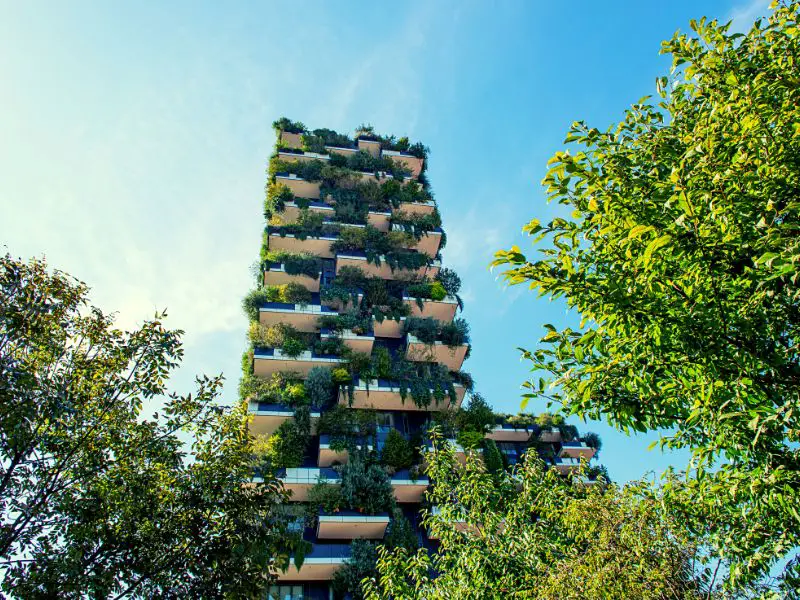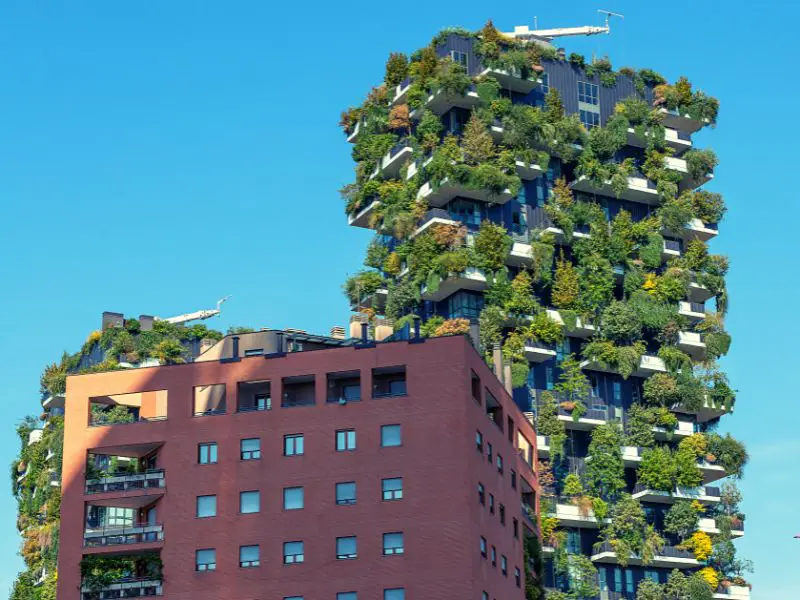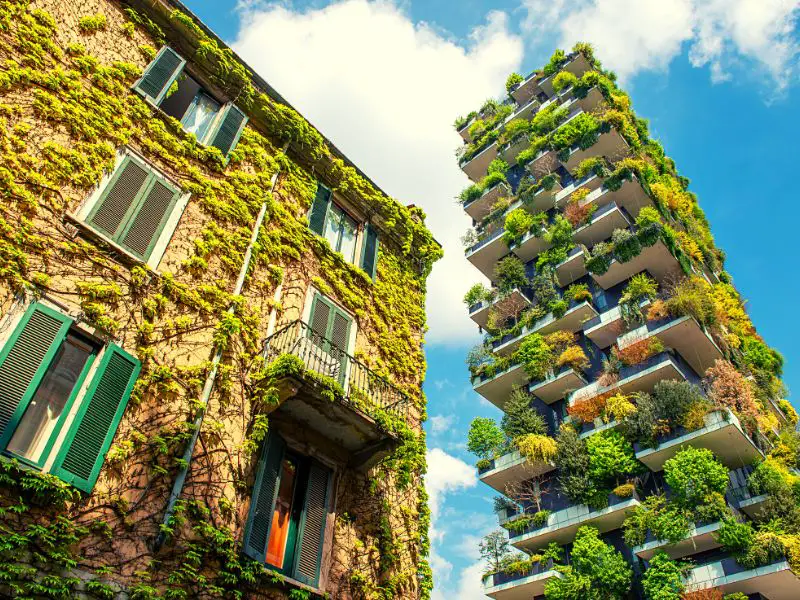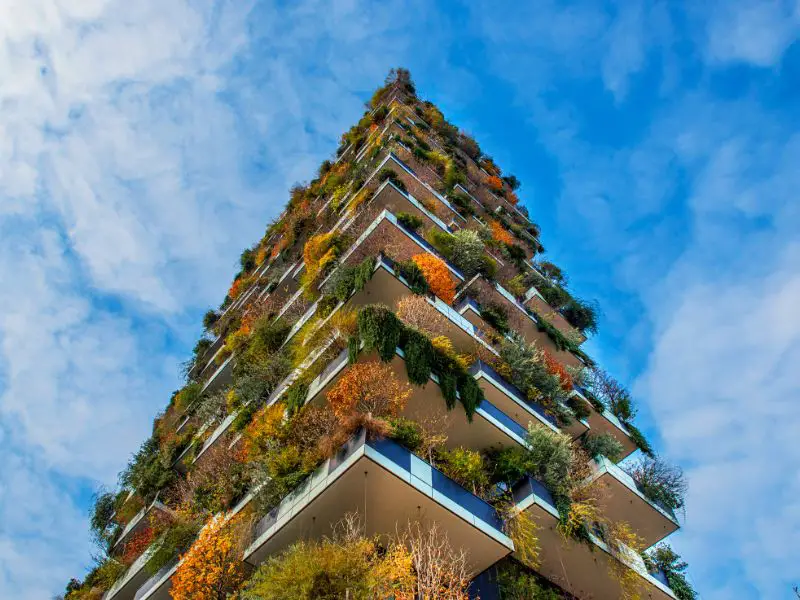Vertical gardens are a growing trend worldwide, as people look for ways to incorporate greenery into their cities’ concrete spaces. These “vertical gardens” consist of interconnected planters, such as plants or flowers, filled with greenery. Buildings and plazas can be built with vertical gardens, beautifying and purifying the area’s air and improving the environment.
In this article, we’ll touch on some aspects of vertical forests and how they can help society as a whole toward a greener outlook.
What Are Vertical Forests?
Vertical forests are skyscrapers that incorporate vegetation, with greenery and different plant species into their design. These buildings, often skyscrapers, are green to the extreme, with trees and plants growing on every surface. Vertical forests are unlike anything ever seen before, and while they are scarce, it’s just a matter of time before they become a more common sight in large cities.

“Vertical forests are a symbol of hope, showing that we can create sustainable and livable cities for the future.”
– CNN
Vertical forests are the brainchild of botanist Patrick Blanc. Blanc was inspired to create vertical forests after spending time in Borneo, where he saw how rainforests could filter the air and produce oxygen for the rest of the ecosystem.
Vertical forests are a new form of green architecture that is a symbiotic relationship between humans and nature. The concept is based on the design of nature’s forests, which create oxygen and provide shelter to animals simultaneously.
The Bosco Verticale
The iconic Bosco Verticale, or in English Vertical Forest, designed by Stefano Boeri Architects in Milan, Italy, and finished in 2014, is probably one of the most valuable structures of the past decade. It is frequently recognized as a source of inspiration for the green construction movement due to its innovative blending of a vertical forest within two towers spanning 44 stories.
Boeri’s innovative vertical forest is a part of the redevelopment of the new Porta Nuova in Milan. Soaring to 116m and 85m high, it features 20,000 different shrubs, plants, and 700 trees of different species. The buildings are primarily self-sufficient because they integrate solar panels, geothermal heating, and a system that uses grey water to irrigate the plants.
How is it good for the environment?
Equaling about 3 hectares of forest, the plant life not only moderates the temperature in summer and winter but also absorbs as much as 30 tonnes of CO2 annually. In addition, it acts as a filter for dust particles, shields the residents from noise pollution, and produces an urban habitat for birds and insects. It is currently home to bumblebees, wild hermit bees, syrphidae (hoverflies), and more than 20 species of birds have made their homes in the residential towers.
Reimagining Urban Space with Architectural Innovation
Stefano Boeri Architetti: Sculpting Green Skyscrapers
Italian architect Stefano Boeri is renowned for orchestrating the harmonious amalgamation of nature and architecture, manifesting the revolutionary concept of “vertical forests” in the bustling metropolis. His firm, Stefano Boeri Architetti, in collaboration with creative minds like Laura Gatti and Shimaa Shalash, has brought to life awe-inspiring residential towers laden with lush greenery, contrasting the conventional concrete appearance of tall buildings.
Revitalization of Urban Environment
The essence of vertical forests is not merely aesthetic. It is a deliberate strategy to regenerate urban environments, steering clear of the pervasive expansion that characterizes city sprawl. By embedding trees, shrubs, and plants within the structural design, these tall buildings are offering a refreshing proximity to nature in an urban environment, combating the deleterious effects of pollution and enhancing the quality of life for city dwellers.
Milan: The Pioneer of Vertical Forests
In 2014, the world witnessed the first embodiment of this vision in Milan. Nestled in the Porta Nuova Isola area, two eminent residential towers emerged, hosting over 100 apartments and presenting a verdant spectacle with nearly 500 trees, 5,000 shrubs, and 11,000 plants. This epitome of green architecture not only attracts visitors but also exemplifies how cities can embody sustainability without compromising on space.
Precultivation and Condition Acclimatization
For the successful integration of greenery in these structures, conditions are meticulously orchestrated. The plants gracing the buildings are pre-cultivated in nurseries, allowing them to adapt to the conditions they would later encounter on the balconies, ensuring their flourishing existence amidst the urban tapestry.
Sustainable Watering System
Ensuring the vitality of the integrated flora, a sustainable irrigation system, powered by solar panels on the roof, pumps groundwater to nourish the trees and shrubs, emphasizing the commitment to eco-friendly solutions. This synergy of technology and nature reflects on every surface of the development, from building facades to roofs, presenting a future where every nook and cranny could potentially harbor life.
Expansion of the Vertical Forest Concept
The footprint of vertical forests is expanding beyond Italian borders. Dutch city Eindhoven, known for its acclaimed design school, is set to integrate vertical forest buildings as a part of social housing projects. Even Egypt is slated to embrace this architectural marvel, with Stefano Boeri unveiling designs for three cube-shaped vertical forest apartment blocks, marking Africa’s introduction to this innovative solution to urban pollution.
Collaborative Architectural Excellence
The realization of these green architectural wonders is not just Stefano Boeri’s solo endeavor. Architects like Gianandrea Barreca and Giovanni La Varra have played pivotal roles in sculpting the landscape of Milan and contributing to the vertical forest’s evolution.
The Inspiration Behind Vertical Forests
Vertical forests were motivated by integrating the concepts used to design the first skyscrapers with initiatives for ecological protection. As vertical forests are the most effective means of reintroducing vegetation to urban areas, architects and developers worldwide may leverage them to develop a more plant- and human-friendly environment.

“Vertical forests are not just a beautiful addition to the urban landscape, they also provide a habitat for birds and insects, and help to increase biodiversity.”
– Treehugger
Vertical forests are the most effective means of reintroducing vegetation to urban areas. As urban dwellers begin to embrace gardening and growing their plants, vertical forests become relevant as urban gardeners can grow their plants at home while going about their daily routines in the city.
This type of architecture is an efficient way of growing plants in an urban environment, as it does not require extensive land and can be efficiently integrated into building designs. This allows urban planners and architects to create green areas in otherwise barren areas in cities. Vertical forests also reduce the need for extensive land for growing trees while preserving natural resources and providing urban biodiversity.
Benefits of Vertical Forests
1. Increases Biodiversity
Vertical Forest tends to increase biodiversity. The creation of vertical forests establishes an urban ecosystem where various kinds of plants create a vertical environment in which birds and insects can also live.
Vertical forests also introduce a new type of attraction and act as a symbol of the natural repopulation of the city by plants and animals. By building Vertical Forests in the city, its corridors can give life to the city’s main parks by connecting the green space of avenues and gardens to weaving them together in different areas where vegetation thrives on its own.

“Vertical forests are a new way to bring green space into densely populated cities, creating a more diverse urban ecosystem.”
– The Guardian
2. Reduces Urban Sprawl
A vertical forest is a way to keep urban expansion from growing too big and out of control. Suppose you think about a vertical forest in terms of urban densification. In that case, each tower of the vertical forest is equivalent to a space of up to 50,000 square meters of family homes, social housing, and buildings, increasing the vertical densification of the city.
3. Improves the Landscape of Urban Areas
The Vertical Forest is a municipal landmark capable of representing new forms of landscapes that change their look over the seasons based on the kind of plants included. The Vertical Forests will give people a unique perspective of a bustling metropolitan reforestation.
4. Reduce Temperatures
In large cities, the buildings are the urban heat islands that absorb heat during the day and release it back at night. On the bright side, vertical forests in big cities could help reduce temperatures in urban centers by 5-7 degrees Celsius. The vertical forests shade the buildings, reducing the heat absorption by a lot. At the same time, the trees release water vapor into the air from their leaves, increasing humidity and cooling things down further.
5. Improved City’s Air Quality
Another reason a green tall building is a good idea is that it helps reduce air pollution. The plants will filter the air by absorbing toxins absorbing carbon dioxide in the air, and releasing fresh oxygen.
The green façade provides natural temperature control, light management, and better air quality. On hot days, some residents rely solely on natural ventilation to maintain comfortable indoor temperatures.
Related: World’s 10 Most Polluted and Least Polluted Countries, Polluting Industries
6. A High Degree of Residents Satisfaction
The idea was to grow a forest vertically and make it as self-sufficient as possible. This provides oxygen for the residents and absorbs carbon dioxide and other harmful gases from the air. This creates a big impact on the city’s wellbeing. In fact, residents of The Bosco Verticale immensely expressed high satisfaction because of the comfort it provides for them.

The green façade of the building is a game changer in terms of providing residents comfort and peace of mind. Since the 1980s, green areas in most major cities have been declining in sharp numbers. Similarly, the urban heat island effect, or the phenomenon by which cities tend to heat up more than the countryside surrounding them, has risen steadily over the last 30 years. Fortunately, the architects behind this project know how to turn this into a great opportunity to not only fight climate change but also to improve our lives.
Eco-Advice and Guides You Should Read: Construction Materials That Are Environmentally Friendly, Disadvantages of Hydropower and Its Impact on the Environment, Plastic Water Bottle Alternatives


Over time, do the plants’ root cause biological weathering of the building materials?